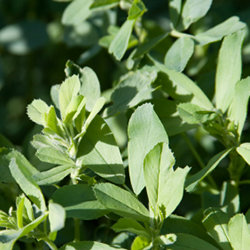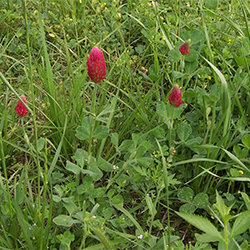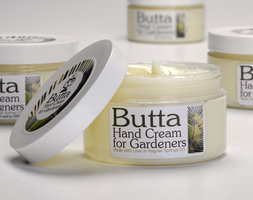





The Discovery
From the days of my youth, I recall many a day spent searching for the elusive four-leaf clover. Clover is such a wonderful plant for a child and when I see it today, it evokes memories of a simpler time. Now and again I would see clover being offered at the Tucson nurseries. This was a bronze clover and is very much meant to be an ornamental. No matter what I did, the clover would perish in the intense heat of the low desert. During a discussion at the Southwest Gardening Forum, I discovered a member who had success with growing a white clover. Albeit, it was in a hay bale, but still. He gave me some but in case it didn't make it, I wanted to order some seed. During my online search, I made a very interesting discovery. Whenever clover was mentioned, the words cover crop and green manure was mentioned as well. What is this all about? I just wanted some clover to grace my garden so I could reminisce the carefree days of my childhood. The words "green manure" absolutely intrigued me.
I did some research and what I discovered changed the way I went about improving my soil.
Fixing Nitrogen From the Air
There are many plants that can be used as soil-improving crops but it turns out clover has an added benefit. Clover is a legume plant. What this means is that it has the ability to fix nitrogen from the air into a form other plants can use. This is done with the help of nitrogen-fixing bacteria on their roots. This to me is amazing. I think of all the times I have added an organic supplement of one kind or another to boost nitrogen levels. It turns out all I had to do was plant some clover! You may be asking, is that it? All I have to do is plant some clover and the soil is transformed? Well, there is a bit more to it than that.
Getting Started
Have I piqued your curiosity, and now you want to know what you need to do to get started? GOOD! This is going to be fun. This is the perfect time of year for many of us to think about starting a cover crop. The vegetables have been harvested and the beds are now empty. Some of us will plant winter vegetables while others will let the bed rest until the spring. If you will be doing the latter, why not put that bed to work? The first thing you need to decide is what crop you want to plant. Where you live will certainly dictate what and when you can plant. Before I go on, it is important that you pick a plant that will survive through the winter. If you live in zones 7-10, you can grow most of the crops mentioned now. The key to growing a successful cover crop is planting them four weeks before frost. The exception to this are the cereals. Rye for example is a cool season annual that can be grown right up to the first frost.
With that said, here is a list of the most common cover crops: alfalfa, vetch, sweet clover, all other clovers, winter peas and southern peas. All of these are legume plants so if you choose one of these, you get the added benefit of the nitrogen-fixing bacteria. There are also the cereals with rye being the most recommended winter cover crop.
Once you have chosen a variety, you can order seed from the Internet. When searching the Garden Watchdog for cover crops, a convenient list comes up with twenty suppliers. Have a look at each one and determine which company has the best selection and price for what you want to grow. Why not order different seed to grow at different times of year? I am certain that once you enjoy your initial success, you will want to continue improving your soil in the same fashion for years to come.
It's Growing, Now What?
Well, like any other plant, you have to look after it but these are not demanding plants. It is a good idea to keep your crop watered and feed now and again with a nitrogen based (preferably organic) fertilizer. It is also a good idea to keep your crop trimmed to prevent it from growing out of control. Besides, you can add those clippings to your compost heap. Talk about doubling up on your soil-improving efforts.
Most cover crops will grow rapidly and before you know it, the time will come when you must kill it. Yes, you must kill it. The time to "harvest" your cover crop is at the point of flowering. I prefer the mowing method. You can also use a burn down herbicide but I enjoy the natural approach. If mowing rye, it is particularly important to do this at the time of flowering, otherwise it may just grow back. Once your crop is mowed, wait until the stems are dry and then till it into the soil. Once the crop is tilled, wait a few days for decomposition to take effect before you begin planting. It is during the decomposition process that the legume plants release the nitrogen into the soil.
I personally prepared a small bed with clover using the above mentioned process with white dutch clover. The soil had a wonderful texture and a rich, "earthy" odor. I planted peas in that particular bed and I am happy to report that all my work paid off. I had a great crop with strong, healthy growth. Coupled with an organic fertilizer with high phosphorus content, we harvested more peas than I could eat. I strongly encourage you all to give growing green manure a try. If nothing else, you could just kneel at the base of your clover crop and try and discover one with four leaves.


 Alfalfa
Crimson Clover
Spring Rye Grass in Oregon
Alfalfa
Crimson Clover
Spring Rye Grass in Oregon
Thumb image was taken by the author. The last three images are from Wikimedia Commons. Good luck!
Copyright © www.100flowers.win Botanic Garden All Rights Reserved